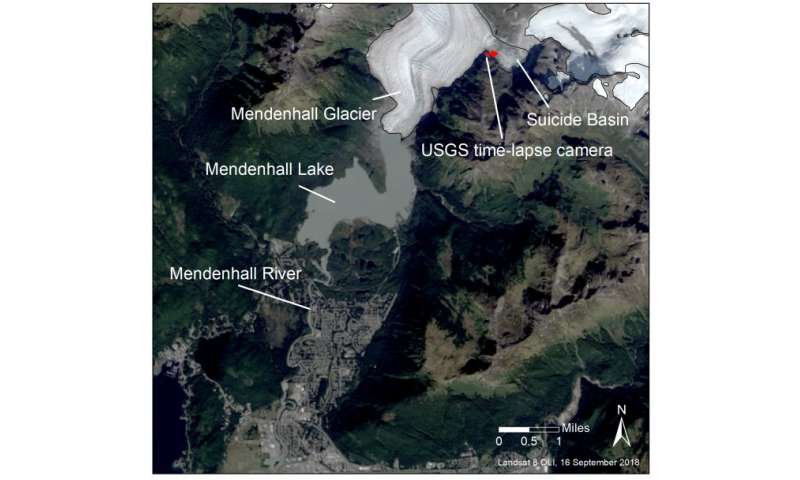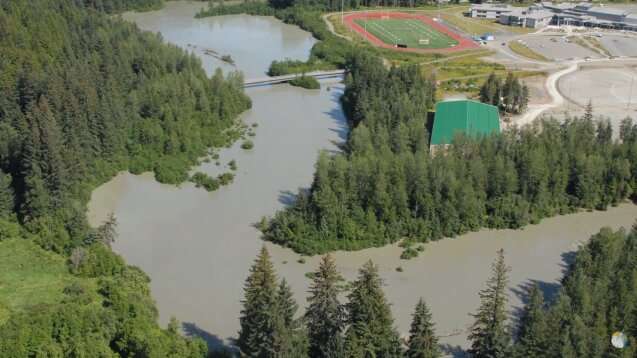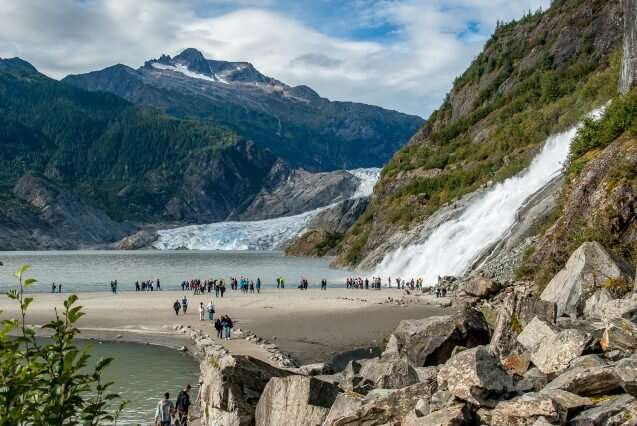by Aastha Uprety, Earth Institute, Columbia University

A map of the Mendenhall Glacier system. Credit: National Weather Service
Every year, residents who live near the banks of the Mendenhall River in Juneau, Alaska know that sometime in summer, their streets will flood. At some point, even in the absence of recent rain, the river will rise and overflow through the roads and into houses. All of this is the work of glacier dynamics several miles away from downtown Juneau.
The flooding is caused by a glacier lake outburst flood that occurs in the Suicide Basin off the side of the 13-mile-long Mendenhall Glacier. Over many months, the basin fills with water from precipitation and glacier melt. As water pressure builds in the lake, it eventually drills through the Mendenhall Glacier and flows downstream, flooding the Mendenhall Valley and impacting the residents of Alaska's state capital. Locals colloquially refer to the phenomenon, which has occurred every year since 2011, as a jӧkulhlaup, a common Icelandic term for an outburst flood.
Glacier lake outburst floods (GLOFs) happen in many glaciated regions around the world. They can occur in many different ways depending on the landscape and ice dynamics at play. Typically, a glacier lake is dammed by ice or a moraine, an accumulation of rocks and sediments deposited by a moving glacier. When this dam fails, the water contained in the lake drains out of the basin and floods the bodies of water it feeds into. This is the process that takes place at Suicide Basin.
The basin formed after the Suicide Glacier, which used to be attached to the Mendenhall, thinned and retreated up the cliff it once flowed down, leaving behind the large bowl it had carved in the ground. Although the Suicide Glacier fully detached from the Mendenhall Glacier in 2006, the first outburst flood from the basin did not occur until the summer of 2011. It came as a surprise to Juneau residents and local researchers alike. While it was not exactly a shock to scientists, since GLOFs are common, scientists had not predicted that this event would happen.
"It was a complete surprise," Eran Hood, an environmental scientist at the University of Alaska Southeast, told GlacierHub. "It was a sunny, beautiful day and the river was going up and up and everyone was like… what's going on?"
Hood and Jason Amundson, who co-lead GLOF modeling research at the University of Alaska Southeast, explained why scientists hadn't predicted the first outburst. The Suicide Basin lake is covered by ice, including the remnants of the Suicide Glacier as well as icebergs calved off the Mendenhall Glacier, so it had not been easily apparent that the basin was filling with water. But when the river flooded, researchers immediately suspected a GLOF and traveled up to the glacier to investigate. After seeing icebergs scattered throughout the drained basin where they were once floating on water, they knew they had found the source of the flood.

Every year, residents who live near the banks of the Mendenhall River in Juneau, Alaska know that sometime in summer, their streets will flood. At some point, even in the absence of recent rain, the river will rise and overflow through the roads and into houses. All of this is the work of glacier dynamics several miles away from downtown Juneau.
The flooding is caused by a glacier lake outburst flood that occurs in the Suicide Basin off the side of the 13-mile-long Mendenhall Glacier. Over many months, the basin fills with water from precipitation and glacier melt. As water pressure builds in the lake, it eventually drills through the Mendenhall Glacier and flows downstream, flooding the Mendenhall Valley and impacting the residents of Alaska's state capital. Locals colloquially refer to the phenomenon, which has occurred every year since 2011, as a jӧkulhlaup, a common Icelandic term for an outburst flood.
Glacier lake outburst floods (GLOFs) happen in many glaciated regions around the world. They can occur in many different ways depending on the landscape and ice dynamics at play. Typically, a glacier lake is dammed by ice or a moraine, an accumulation of rocks and sediments deposited by a moving glacier. When this dam fails, the water contained in the lake drains out of the basin and floods the bodies of water it feeds into. This is the process that takes place at Suicide Basin.
The basin formed after the Suicide Glacier, which used to be attached to the Mendenhall, thinned and retreated up the cliff it once flowed down, leaving behind the large bowl it had carved in the ground. Although the Suicide Glacier fully detached from the Mendenhall Glacier in 2006, the first outburst flood from the basin did not occur until the summer of 2011. It came as a surprise to Juneau residents and local researchers alike. While it was not exactly a shock to scientists, since GLOFs are common, scientists had not predicted that this event would happen.
"It was a complete surprise," Eran Hood, an environmental scientist at the University of Alaska Southeast, told GlacierHub. "It was a sunny, beautiful day and the river was going up and up and everyone was like… what's going on?"
Hood and Jason Amundson, who co-lead GLOF modeling research at the University of Alaska Southeast, explained why scientists hadn't predicted the first outburst. The Suicide Basin lake is covered by ice, including the remnants of the Suicide Glacier as well as icebergs calved off the Mendenhall Glacier, so it had not been easily apparent that the basin was filling with water. But when the river flooded, researchers immediately suspected a GLOF and traveled up to the glacier to investigate. After seeing icebergs scattered throughout the drained basin where they were once floating on water, they knew they had found the source of the flood.

The flooded Mendenhall River. Credit: International Arctic Research Center via YouTube
When a typical outburst flood occurs, the river rises exponentially and the peak of the flood lasts a few days. The effects are far from catastrophic—in fact, just a handful of homes on the eastern bank of the Mendenhall River usually see flooding—but the impacts are not insignificant and could worsen at any time. One example is riverbank erosion, a long-term environmental concern for locals, which is exacerbated due to the yearly floods.
Dina Abdel-Fattah, an assistant professor at the Arctic University of Norway and Stockholm University who has also studied the impact of the floods in Juneau, spoke to GlacierHub about the wider economic effects of the floods. Tourism is important in Juneau, she noted, and when the river floods, operations are temporarily shut down. Campgrounds are closed and campers are evacuated, the visitor center closes trails, and businesses stop renting out kayaks and other equipment. This all adds up to significant economic losses.
Thankfully, the damage has typically been under control. Tom Mattice, emergency program manager for the City and Borough of Juneau, told GlacierHub that the city government has developed an organized response to the floods that they are comfortable implementing.

When a typical outburst flood occurs, the river rises exponentially and the peak of the flood lasts a few days. The effects are far from catastrophic—in fact, just a handful of homes on the eastern bank of the Mendenhall River usually see flooding—but the impacts are not insignificant and could worsen at any time. One example is riverbank erosion, a long-term environmental concern for locals, which is exacerbated due to the yearly floods.
Dina Abdel-Fattah, an assistant professor at the Arctic University of Norway and Stockholm University who has also studied the impact of the floods in Juneau, spoke to GlacierHub about the wider economic effects of the floods. Tourism is important in Juneau, she noted, and when the river floods, operations are temporarily shut down. Campgrounds are closed and campers are evacuated, the visitor center closes trails, and businesses stop renting out kayaks and other equipment. This all adds up to significant economic losses.
Thankfully, the damage has typically been under control. Tom Mattice, emergency program manager for the City and Borough of Juneau, told GlacierHub that the city government has developed an organized response to the floods that they are comfortable implementing.

Nearly 500,000 tourists visit the Mendenhall Glacier every year. Credit: Rod Ramsell via Unsplash
At the same time, however, GLOFs are unpredictable and constantly changing. Hood and Amundson explained that there is only so much that scientific research can predict about their intensity or characteristics. The floods in Juneau have varied from year to year. One year, the river flooded multiple times throughout the summer at lower intensities than usual instead of all at once. In other instances, water spilled over the top of the Mendenhall Glacier instead of only going through it. Any slight spike in the intensity of flooding, or co-incidence with the rainstorms that are common to the region, could impact more neighborhoods and have dangerous consequences.
Following the first flood in 2011, a team of researchers led by Christian Kienholz, a former glaciologist at the University of Alaska, began to closely monitor and study the basin. Scientists use a variety of methods to do so, including pressure monitors, aerial drones that survey the basin as it fills, remote sensing to determine the topography of the basin, and time-lapse cameras. According to Kienholz, these tools help researchers understand the capacity of the basin, how quickly it drains, and whether it drains completely—all of which are critical to making predictions about GLOFs. Photos of the basin, which allow scientists and local residents to monitor the rising water level, can be seen at the National Weather Service (NWS) website.
With all this information, scientists are able to predict the floods just a few days in advance. Once the water in the basin has risen to its highest possible level, they know that the dam will break and the water will start flowing downstream. This gives the city a day or two of preparation before the floods arrive. Impacted residents sandbag their homes and the city monitors and shuts down roads and power lines as necessary.

At the same time, however, GLOFs are unpredictable and constantly changing. Hood and Amundson explained that there is only so much that scientific research can predict about their intensity or characteristics. The floods in Juneau have varied from year to year. One year, the river flooded multiple times throughout the summer at lower intensities than usual instead of all at once. In other instances, water spilled over the top of the Mendenhall Glacier instead of only going through it. Any slight spike in the intensity of flooding, or co-incidence with the rainstorms that are common to the region, could impact more neighborhoods and have dangerous consequences.
Following the first flood in 2011, a team of researchers led by Christian Kienholz, a former glaciologist at the University of Alaska, began to closely monitor and study the basin. Scientists use a variety of methods to do so, including pressure monitors, aerial drones that survey the basin as it fills, remote sensing to determine the topography of the basin, and time-lapse cameras. According to Kienholz, these tools help researchers understand the capacity of the basin, how quickly it drains, and whether it drains completely—all of which are critical to making predictions about GLOFs. Photos of the basin, which allow scientists and local residents to monitor the rising water level, can be seen at the National Weather Service (NWS) website.
With all this information, scientists are able to predict the floods just a few days in advance. Once the water in the basin has risen to its highest possible level, they know that the dam will break and the water will start flowing downstream. This gives the city a day or two of preparation before the floods arrive. Impacted residents sandbag their homes and the city monitors and shuts down roads and power lines as necessary.

The Mendenhall Glacier as seen from Mendenhall Lake. Credit: Frank Towery via Flickr
A key point of Juneau's response to the GLOFs is the teamwork and co-production of knowledge among various entities including the University of Alaska, the city of Juneau, the U.S. Geological Survey, and the NWS. By fostering relationships between organizations and individuals, many people are now very well-informed about the outburst floods and the response has become routine. "I think everybody and every organization has brought a little bit to the table," Mattice told GlacierHub. "I truly feel the reason that our models are as good as they are, and our warnings are as accurate as they are, has really been the team that has come together and done all this over the years."
Local residents play a role as well and might constitute untapped potential. Abdel-Fattah explained to GlacierHub that residents who are directly impacted have mostly lived by the river the whole time this has been happening and understand the flooding potential intimately. She sees an opportunity to integrate local knowledge into the planning process. "I think a lot of people that get affected by [the floods] want to be involved," Abdel-Fattah said. "People that are affected [by natural hazards], over the long-term, know best in some ways."
Similar to residents who face a regular wildfire or hurricane season, for example, people who are directly impacted by outburst floods, in Alaska and around the world, are on alert during flood season. Gabriel Wolken, who manages the Climate and Cryosphere Hazards Program for the Alaska Department of Natural Resources, explained to GlacierHub how, like with any flooding event, the threat of GLOFs forces people to consider their safety, thinking about whether they should evacuate their homes and whether they'll be able to get into town or to hospitals. Wolken told GlacierHub, "It makes people really consider their environment, where they live, and the fragility of essentially everything that we have."
In Juneau, even though damage has been minimal and under control so far, there is still a real human impact. GLOFs are unpredictable, and thus researchers, locals, and the government never underestimate their potential. But the response to the outburst floods in Juneau— developed over years—has become reliably routine, thanks to scientific research and flourishing partnerships among various entities. Abdel-Fattah told GlacierHub, "It's a pretty good success story, I would say."
Explore furtherChina rushes to contain floods after record rainfall
Provided by Earth Institute, Columbia University
This story is republished courtesy of Earth Institute, Columbia University http://blogs.ei.columbia.edu.
A key point of Juneau's response to the GLOFs is the teamwork and co-production of knowledge among various entities including the University of Alaska, the city of Juneau, the U.S. Geological Survey, and the NWS. By fostering relationships between organizations and individuals, many people are now very well-informed about the outburst floods and the response has become routine. "I think everybody and every organization has brought a little bit to the table," Mattice told GlacierHub. "I truly feel the reason that our models are as good as they are, and our warnings are as accurate as they are, has really been the team that has come together and done all this over the years."
Local residents play a role as well and might constitute untapped potential. Abdel-Fattah explained to GlacierHub that residents who are directly impacted have mostly lived by the river the whole time this has been happening and understand the flooding potential intimately. She sees an opportunity to integrate local knowledge into the planning process. "I think a lot of people that get affected by [the floods] want to be involved," Abdel-Fattah said. "People that are affected [by natural hazards], over the long-term, know best in some ways."
Similar to residents who face a regular wildfire or hurricane season, for example, people who are directly impacted by outburst floods, in Alaska and around the world, are on alert during flood season. Gabriel Wolken, who manages the Climate and Cryosphere Hazards Program for the Alaska Department of Natural Resources, explained to GlacierHub how, like with any flooding event, the threat of GLOFs forces people to consider their safety, thinking about whether they should evacuate their homes and whether they'll be able to get into town or to hospitals. Wolken told GlacierHub, "It makes people really consider their environment, where they live, and the fragility of essentially everything that we have."
In Juneau, even though damage has been minimal and under control so far, there is still a real human impact. GLOFs are unpredictable, and thus researchers, locals, and the government never underestimate their potential. But the response to the outburst floods in Juneau— developed over years—has become reliably routine, thanks to scientific research and flourishing partnerships among various entities. Abdel-Fattah told GlacierHub, "It's a pretty good success story, I would say."
Explore furtherChina rushes to contain floods after record rainfall
Provided by Earth Institute, Columbia University
This story is republished courtesy of Earth Institute, Columbia University http://blogs.ei.columbia.edu.
No comments:
Post a Comment